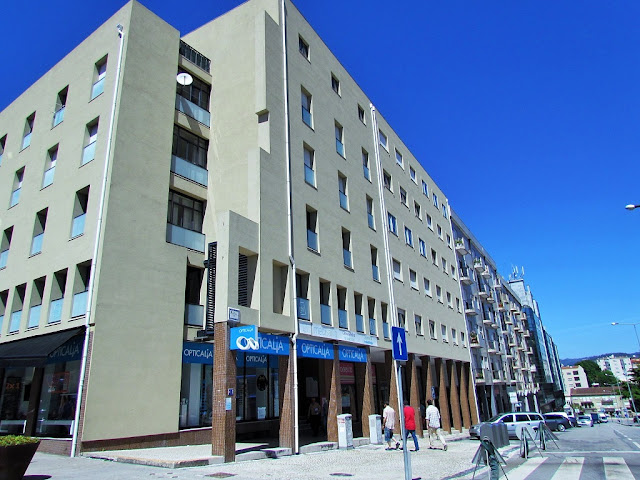SÃO JOÃO DA MADEIRA
N 40º 54' 14.7''; W 8º 29' 44.8''
São João da Madeira stood out also recently by introducing in 2011 the Industrial Tourism in Portugal and, in 2012, for becoming the first Portuguese municipality to offer almost integral wireless coverage on its municipal area.
Its economy is based on services and industry, employing 62% in secondary and 38% in tertiary sectors. In 2007, there were 3660 registered companies dominated by micro and small businesses and employing 74% of the workers. São João da Madeira's motto, translated as "Labor, City of Work", appeals to its industrial history.
In 2007, there were 3660 companies in São João da Madeira: despite being the smallest municipality in size in Portugal, it is the twentieth in economic turnover. It is the head of the shoe industry in Portugal, an important industrial activity in Portugal, having the seat of the Shoe Technological Centre. Beyond that, the city is developing a Science Park and main Centro Empresarial e Tecnológico (Business and Technology Centre), as well as an important commercial, financial, and service center of the region, having its largest Shopping Mall and the largest concentration of banks. Inaugurated in 2008 by President Aníbal Cavaco Silva the Centre is a modern project by architect Filipe Oliveira Dias, that services as an incubator for high technology businesses in order to diversify the local market. It is actually the first of ten buildings in the zone, of a planned 80,000 square meter technological park, including the Núcleo de Investigação e Desenvolvimento (Investigation and Development Nucleus). In 2009, a series of protocols of understanding was signed to establish a regional network of "Innovation and Competitivity" between business and education, in order to foster technological innovation.
Shoe manufacturing has been one of the city's main economic industries, and regularly, the city has been referred to as "a Capital do Calçado" (the Capital of Footwear); many of Portugal's shoe manufacturers and ancillary businesses, including the Centro Tecnológico do Calçado (Footwear Technology Centre) and Centro de Formação Profissional da Indústria do Calçado (Footwear Industry Centre for Professional Learning) are based in São João da Madeira. Similarly, regional industries have been responsible for the production of 20% of the world's felt hats and continue to be the major national producer. The quality of São João da Madeira's head apparel has, at one time, been recognized internationally, and incorporated in fashion house (such as Hermès). In addition, the movie industry was responsible for supporting this industry, with headwear produced for films such as Public Enemies, Indiana Jones and the Kingdom of the Crystal Skull (Indiana Jones' hat, for example) and the Mad Hatter's famous hat in Alice in Wonderland. Other secondary industries in the economy include automobile components, industrial textiles, mattresses, glues, and tubing manufacturing, which are concentrated in four industrial zones: Travessas, Orreiro, Devesa-Velha e Oliva.
Its central place within the urban hierarchy has slowly consolidated many of the main services of the Entre Douro e Vouga subregion; along with Santa Maria da Feira, it has contributed to the polycentrism of the Greater Porto basin. São João da Madeira is an important banking and financial center; in 2007, there were 1288 employed in the banking sector, equivalent to the same number in Aveiro.
In 2014 the town's schools began Mandarin language education.
Tourism
Industrial tourism has increased, and S. João da Madeira was the first city in the country to introduce this tourism.
The routes include the only pencil factory in operation in Portugal, the shoe industry, and the head-wear industry.
A Vocational Training Centre of the Footwear Industry and the Portuguese Technological Footwear Centre are part of this industrial tourism route, as well as the Hat Museum, one symbol of the city and unique in the Iberian Peninsula.
Industrial tourism has increased, and S. João da Madeira was the first city in the country to introduce this tourism.
The routes include the only pencil factory in operation in Portugal, the shoe industry, and the head-wear industry.
A Vocational Training Centre of the Footwear Industry and the Portuguese Technological Footwear Centre are part of this industrial tourism route, as well as the Hat Museum, one symbol of the city and unique in the Iberian Peninsula.
💓💓💓💓💓
SEARCH IN ALPHABETICAL ORDER
IN THE DISTRICT OF AVEIRO

Águeda;
Aguada de Baixo;
Albergaria-a-Velha;
Alvarenga + Paradinha;
Anadia;
Arões + Trebilhadouro;
Arouca + Meitriz;
Arouca Unesco Global Geopark;
Avanca;
AVEIRO;
Bussaco;
Castelo de Paiva;
Cortegaça;
Costa Nova;
Covelo de Paivó + Janarde + Drave;
Curia;
Esmoriz;
Estarreja;
Espinho;
Fábrica da Vista Alegre;
Freita Mountain (Serra da Freita);
Ílhavo;
Mealhada;
Murtosa;
Luso;
Oiã (Oliveira do Bairro);
Oliveira de Azeméis;
Oliveira do Bairro;
Ovar;
Palhaça (Aveiro);
Paramos;
Pateira de Fermentelos;
Praia da Barra;
Praia da Vagueira;
Ria de Aveiro;
Salreu;
Sangalhos;
Santa Maria da Feira;
São João da Madeira;
Sever do Vouga;
Silvalde;
Sosa (Vagos);
Vagos;
Vale de Cambra;
Válega;
Oliveira de Azeméis;
Oliveira do Bairro;
Ovar;
Palhaça (Aveiro);
Paramos;
Pateira de Fermentelos;
Praia da Barra;
Praia da Vagueira;
Ria de Aveiro;
Salreu;
Sangalhos;
Santa Maria da Feira;
São João da Madeira;
Sever do Vouga;
Silvalde;
Sosa (Vagos);
Vagos;
Vale de Cambra;
Válega;
Return to mainland Portugal &
the Azores and Madeira islands





























































